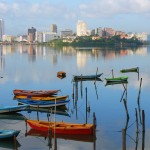International travel checklist: essential steps to take before your trip
Planning an international trip is exciting, but it also requires careful preparation to ensure everything goes smoothly. From booking flights and accommodations to packing the right essentials, having a well-organized plan is key to avoiding stress and last-minute surprises. That’s where an international travel checklist comes in handy — helping you stay on top of everything you need to do before you take off.
In this guide, I will walk you through the essential steps to prepare for your upcoming adventure abroad. Whether it’s making sure your passport is up to date, arranging travel insurance like SafetyWing’s Nomad Insurance, or setting up an international phone plan, this checklist will cover everything you need to ensure a worry-free journey.
International Travel Checklist
Let’s start with the basics: once you decide to travel, you’ll need to choose your destination, figure out your transportation options, estimate your budget, and make arrangements for accommodations. Don’t forget the fun parts, like creating itineraries and finding exciting activities to fill your days!
In addition to these logistical details, though, there are some steps that I always take before traveling internationally. It’s crucial to consider your health and safety, organizing things like finances and communications and making sure you have all the necessary documentation. By addressing these important topics on your international travel checklist, you’ll be better prepared for a smooth and enjoyable trip.

Important Documents to Prepare
Check Your Passport
If you’re planning to travel abroad, one of the first steps is to ensure you have a valid passport. The process for obtaining one varies by country, but generally involves gathering the required documents, paying the necessary fees, and scheduling an appointment at your local passport office or embassy. Depending on where you live, this process might take several weeks, so it’s a good idea to start early.
Do you already have a passport? Don’t skip this step just yet! You have to remember to check its expiration date, as many destinations require your passport to be valid for at least six months beyond the date of your return. To avoid any last-minute surprises, consult the embassy of each country you’re visiting to confirm their entry requirements.
Check Visa Requirements
Visa requirements vary widely depending on your nationality and destination. While some travelers can enter many countries without a visa, others might need one even for short tourist visits. Be sure to research the visa requirements for all the countries on your itinerary, including any transit countries where you might have layovers.
If you’re traveling for work, study, or other non-tourist purposes, don’t assume you can enter on a tourist visa and adjust your status later. In most cases, you’ll need to apply for the correct visa type before you leave your home country.
Additionally, some destinations may require extra documentation, such as hotel bookings, proof of onward travel or invitation letters to allow your entrance in the country. Though these are not always requested, it’s best to be prepared to avoid any issues at the border.
Save Important Documents in the Cloud
In today’s digital world, storing important documents in the cloud makes life much easier—not just for travel, but in everyday situations as well. If you encounter any trouble while traveling, you’ll be grateful for the few minutes you took to scan and upload your essential documents to a service like Dropbox, Google Drive, iCloud, or even your email.
Some important documents to consider saving in the cloud include the first pages of your passport (including visas), national identity card, vaccination certificates (such as for yellow fever), bank statements, student or employment verification, driver’s license, medical prescriptions if you require medication, receipts for valuables you’re bringing along, your travel insurance policy, and proof of address in your home country.
I also recommend creating a dedicated folder for each trip and organizing it with all the necessary documentation, such as e-tickets, hotel reservations, train tickets, car rental receipts etc.
Get an International Driving Permit (IDP)
The International Driving Permit (IDP) – often referred to as the “international driver’s license” – can be an important document if you’re planning to drive abroad. While many car rental companies and countries don’t require it, having an IDP can be a requirement in some destinations and prevent confusion in places where your local driver’s license might not be easily understood or recognized.
The IDP is especially useful if you’re involved in an accident, pulled over by local authorities, or driving in countries where the language is very different from your own. In some cases, presenting a local license without the IDP could lead to misunderstandings or unnecessary complications. So if you’re thinking of driving abroad, it’s worth getting it.

Health and Safety Precautions
Get Health Checkups
If you’re going to be away for a long time or if you have a medical condition that requires monitoring, it’s a good idea to go to the doctor for that old check-up and reduce the chance of unpleasant surprises during the trip.
Take the opportunity to ask which medicines you should include in your travel medicine kit and ask for prescriptions for whatever you need, remembering to keep them along with the medicines in your carry-on luggage.
In addition, if the destination you’re visiting is susceptible to serious diseases that don’t exist in your home country, it may be useful to consult a travel medicine clinic to find out about vaccinations and other precautions you can take before and during the trip.
Schedule Vaccinations
Whether you’re traveling or staying at home, keeping your vaccinations up to date is always a smart move, not only to safeguard your own health but also to avoid spreading diseases to other people.
Vaccines are available through public health systems in many countries, while others may require a visit to specialized Travel Health Clinics depending on your destination.
It’s important to note that some vaccines require a waiting period of 10 days to 6 weeks to provide the full protective benefits. Therefore, starting your research and vaccinations well in advance of your trip is essential.
Additionally, certain vaccines, such as for yellow fever, are increasingly required for entry into various countries, and you might need to get an international certificate in addition to your national one.
Assemble a First-Aid Kit
When it comes to staying healthy while traveling, having a well-stocked travel medicine kit is very useful. I like to include the medications I regularly take, such as pain relievers, antipyretics, muscle relaxants, anti-inflammatories, and remedies for nausea, indigestion, sore throat, and flu, besides from a thermometer.
In addition to these, I add a few items I don’t use often but might need on the road, like antihistamines, ointments for burns and insect bites, and eye drops. Some travelers even go the extra mile and carry gauze and adhesive tape.
To save up space, I prefer to remove everything from its packaging and keep the medications along with their instructions in a small bag.
It’s a good idea to consult your doctor for personalized advice, especially if your trip will be long. If you think you might need medications that you usually don’t take, jot down the active ingredients. This way, if you find yourself needing something while away, it’ll be easier to find the right medicine at your destination. Fingers crossed you won’t need it!
Purchase Travel Insurance
Travel insurance is a must for international trips, and in some countries, it is even a requirement for entry. Especially if you’re planning to spend extended periods abroad, you’re likely to need medical assistance at some point. And even on shorter trips, unexpected events can happen.
Unfortunately, I say this from my own experience. I’ve personally encountered situations where I needed travel insurance during exchange programs and vacations in places like France, Mexico, Hungary, the US, Germany and the UK. It’s never been anything too bad, but still, I don’t even like to think about how much money I would have spent if I hadn’t been insured.
I’ve heard stories of travelers facing huge medical bills after needing assistance abroad. For instance, a simple treatment for a broken arm in the United States can cost up to $20,000! While the cost of travel insurance varies based on factors like trip duration, coverage level, and the traveler’s age, it’s a small price to pay compared to the potential expenses you might face without it.
A great option to consider is SafetyWing’s Nomad Insurance, designed for long-term travelers and digital nomads. This insurance provides flexible coverage that adapts to your travel needs, whether you’re on a short trip or an extended journey.
It gives you the peace of mind of knowing that if something goes wrong you’ve got comprehensive medical coverage, including doctor visits, hospital stays, and prescription medicines. Their travel insurance also includes coverage for emergency evacuation services, lost luggage, delayed flights and more.
One standout aspect of SafetyWing’s Nomad Insurance is that it can be purchased while you’re already traveling. This means you don’t have to worry about getting insured before your trip, making it a convenient option for spontaneous adventurers. Furthermore, SafetyWing has a straightforward claims process and offers customer support available 24/7.
Check out SafetyWing’s current pricing, policies and add-ons and sign up in a few clicks.

Review Travel Safety Tips for Your Destination
If you’re traveling somewhere where you’ve never been, it’s also good to familiarize yourself with travel safety tips specific to your destination. Understanding local customs, laws, and potential safety concerns can minimize risks during your trip.
Start by researching the general safety situation in your destination. Government websites, travel forums, and local news sources can provide valuable insights into any current advisories, common scams, or areas to avoid. However, my best advice is to speak to travelers who have been there recently, since government agencies and the media can often make things seem a lot worse than they actually are, especially in the Global South.
Besides, always consider cultural norms and practices that might affect your safety. For instance, some countries have specific dress codes or behaviors that are expected in public spaces. Being respectful of local customs can help you avoid misunderstandings and enhance your travel experience.
Financial Preparation
Set Up a Travel Budget
Coming up with a travel budget is an essential step in any national or international travel checklist, especially when going abroad and dealing with a different currency and average costs that might be very different than those at home. This helps you keep track of your expenses and ensures you don’t overspend.
Start by estimating your overall costs, including flights, accommodation, food, activities, transportation, and any miscellaneous expenses. You can do that by speaking to people who have been to that country recently, going into online forums, using websites like Numbeo and Expatistan and checking the actual websites for tourist activities, transportation and accommodation (like Booking.com).
Then, break down your budget into daily spending limits to help you manage your money throughout the trip. Consider using budgeting apps to track your expenses in real time. Also, remember to allocate some funds for unexpected costs that may arise (there are always some!).
Buy Foreign Currency or Set Up an International Account
Depending on your destination, it may be good to exchange some money before you arrive, especially for initial expenses like transportation or food. Research the best exchange rates and use a reliable currency exchange service. If you can exchange money at home, it’s good to start doing it ahead of time, getting small amounts in different days to average out fluctuations in the exchange rate.
These days, it’s much easier to deal with money when going abroad, since there are plenty international back accounts and travel-friendly debit card that allow you to withdraw money in local currency without incurring high fees. You can even “store” money in your account in the destination’s currency by using services like Wise and other fintech companies offer accounts specifically designed for travelers.
I personally like to carry some cash, a travel debit card and also a credit card for emergencies. For safety, I prefer to keep all that stored in a money belt.

Communication and Connectivity
Research Phone Plans
Staying connected while traveling abroad is essential, whether you need to navigate, communicate with friends and family, or access important information.
There are many ways to do that, from setting up an international phone plan with your current mobile provider or companies targeted at travelers to purchasing a local SIM card upon arrival.
Before your trip, check with your carrier about their international options, which may include data packages, text messaging, and call allowances. I always opt for local SIM cards, which often provide better rates for data and calls.
Download Offline Maps and Travel Apps
Another important item on my international travel checklist is to download offline maps and travel apps. Apps like Google Maps allow you to save specific areas for offline use, ensuring you can navigate even without an internet connection. This is very useful in regions where Wi-Fi may be limited or data coverage is spotty.
I also like to use apps like Google Translate, transportation apps (Uber or its local equivalent and Moovit for buses), Maps.Me if I’m doing hikes, Waze if I’m driving, SplitWise if I’m traveling with a friend and want to split costs, and so on. Oh, and if you want to listen to podcasts or music and watch movies or series while you’re on the road, don’t forget to download these too (I use Spotify and Netflix).
Learn the basics of the local language
Now, don’t worry—I’m not suggesting you need to master ten different languages for your Eurotrip or your adventures in Southeast Asia. In many cases, English and a little bit of miming can get you pretty far. However, knowing a few key phrases in the local language can significantly enhance your travel experience.
While having access to tools like Google Translate is invaluable, knowing a few local phrases can be a delightful icebreaker and shows that you’re making an effort to connect with the culture. Besides from showing respect, this can lead to making new friends and discovering hidden gems that aren’t in any guidebook.
I like to download a basic conversation dictionary on my phone or Kindle before I travel. This way, I can easily learn and reference essential words like “bathroom,” “exit,” “entrance,” “pull,” “push,” and numbers. These can be very helpful in everyday situations, from navigating public transport to ordering food.

Packing Essentials
When it comes to packing for your trip, there’s no one-size-fits-all international travel checklist, sou have to consider the destination and the activities you plan to engage in. Depending on where you’re headed—whether it’s a winter wonderland, a tropical beach, or adventurous hikes in a remote forest—you may need specialized clothing and equipment that you don’t use in your everyday life.
For instance, if you’re traveling to a cold country in the winter, you’ll likely need thermal layers, waterproof jackets, and insulated boots. Adventure seekers might require camping gear like tents, sleeping bags, inflatable mattresses, and hiking shoes.
Additionally, there are items that can enhance any trip, like travel locks, Ziploc bags for toiletries, small bottles for carry-on liquids, and sleep masks to help you rest on planes, buses, trains or shared rooms in hostels.
Don’t Forget Travel Adapters and Other Gadgets
When preparing for international travel, one of the most commonly overlooked essentials is a travel adapter. Different countries often use various types of electrical outlets, so having the right adapter is crucial for charging your devices. It’s good to invest in a universal travel adapter, which can accommodate multiple plug types and often includes USB ports as well.
In addition to adapters, consider packing a portable charger, which is especially useful during long days of sightseeing when access to power outlets may be limited. Many of my nomadic friends are also big fans of noise-canceling headphones, which are quite useful during long flights or bus rides.
Start Packing Early
To avoid overpacking or missing essential items, it’s wise to start planning ahead of time. Many travelers experience a common anxiety known as “I think I’m forgetting something” syndrome when preparing for a trip, and I’m no exception.
To combat this, I use two simple strategies: first, I make a packing list that outlines everything I intend to bring, and second, I start packing a few days in advance. This gives me ample time to remember forgotten items and reconsider any impulse additions.
If you need anything that you don’t own, determine what you can borrow from friends or family, what you might need to purchase before your trip, and what could be easier to get at your destination.
Keep a close eye on your footwear, as breaking in new hiking boots right before a trip can lead to uncomfortable blisters. It’s always best to wear any new shoes for a bit before you travel with them.
Another helpful tip is to take a photo of your packed suitcase or backpack before you head to the airport. This can help you identify it later, should it get lost by the airline (knock on wood).

Final Pre-Departure Checks
Before you head to the airport, take a moment to reconfirm your flights and accommodations. Airlines may change schedules or gate assignments, so checking your flight status will help you avoid any last-minute surprises.
And if you’re flying from a city with more than one airport, double-check which one you should go to. I recently came short of missing a flight because I was headed to the wrong airport – luckily, I left home early and noticed the mistake on my way there.
If you want to be super careful, you can also contact your hotel or rental property to confirm your reservation, especially if you made it well in advance or if you booked it through a third-party platform.
Review your travel itinerary to ensure everything is as planned. Check the timings for any connecting flights, transportation arrangements, and any activities or tours you’ve scheduled. If you’re relying on public transport, confirm the schedules to avoid any delays. Having your itinerary handy—either in print or on your mobile device—can be helpful too.
And that’s a wrap for this international travel checklist. I hope you’ve found it useful. I’ve been referring to it myself for many years and thanks to it, my trips abroad have been quite smooth. Safe travels!
Disclaimer: When you purchase your travel insurance or book accommodation using the links on the blog, I earn a small commission that allows me to continue producing useful content for travelers, and you don’t pay anything extra for it. Janelas Abertas values transparency with its readers and always makes it clear when there is financial compensation involved in mentioning a service or product.
















0 Comentários